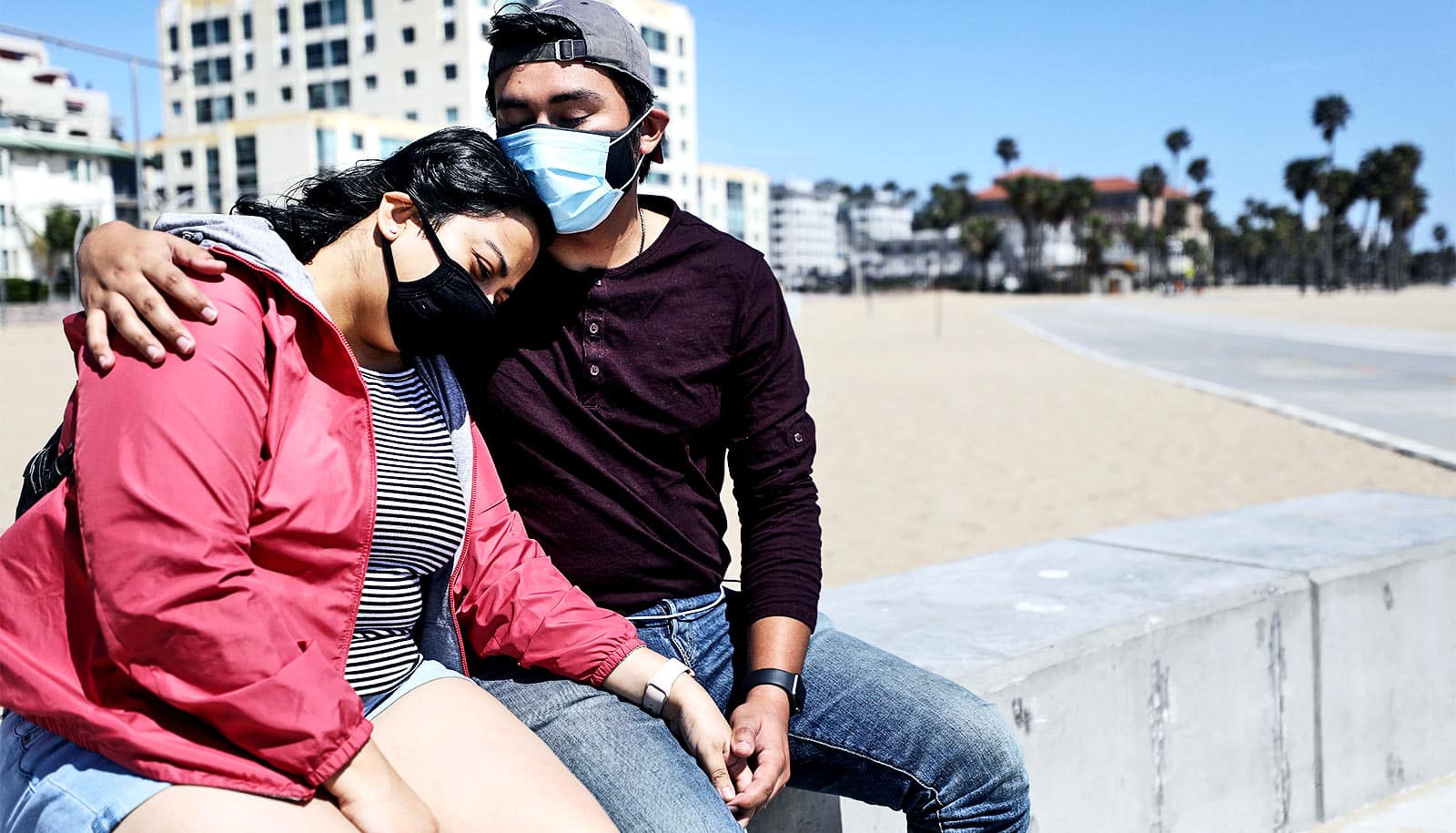Anxious, depressed, or exhausted? You’re not alone. A clinical psychologist explains “pandemic fatigue.”
Some experts warn the next pandemic challenge will be to “flatten the mental health curve.”
When widespread lockdowns began across the United States in response to COVID-19, many hoped life would get back to normal in a couple of weeks. Now, four months later, there is still no end in sight for the pandemic, and the resurgence of the virus in many parts of the country has forced businesses that had reopened to close again.
The coronavirus has brought with it a number of stressors—including job losses, social isolation, child care challenges, and general uncertainty—that tax the mental health of millions of people worldwide.
David Sbarra, a clinical psychologist and professor in the psychology department at the University of Arizona, directs the department’s Laboratory for Social Connectedness and Health and studies how human health—both psychological and physical—is tied to our close relationships.
Here, he discusses how the prolonged nature of this unprecedented health crisis might contribute to chronic stress and “pandemic fatigue:”
COVID-19 has been with us for several months now. Are people experiencing pandemic fatigue as the situation wears on?
The idea that there’s a specific syndrome we might call “pandemic fatigue” is probably just a shorthand way of saying that we’ve reached a bit of a mental health breaking point. We’re stressed, isolated, lonely, burned out, and more depressed and anxious than we’ve been in a long time.
Many people spent the spring indoors with the hope of returning to normal in the summer, but those hopes were dashed. According to recent data from the Census Bureau, nearly a third of Americans are reporting symptoms of depression and anxiety—or both.
The urgency of these problems should not be overlooked, and new data suggest that the fallout of these problems will be significant, with upward of 75,000 more people dying from drug or alcohol misuse and suicide than we would have expected absent the coronavirus. Some experts are beginning to argue that one of our next big challenges in facing COVID will be to “flatten the mental health curve.”
This pandemic comes with multiple stressors beyond the virus itself. What are some of the biggest factors impacting mental health?
It’s not hard to see what’s driving this distress. We have mass unemployment and economic uncertainty. With the closures of schools, child care centers, and summer camps, many of us are pulled between the worlds of work and caregiving in ways that were unimaginable just a few months ago.
Older adults and others at the greatest risk are increasingly isolated from their loved ones, making loneliness especially common. On top of all this, the US is facing an epic failure in its ability to get the virus under control and, as a consequence, uncertainty and despair are looming large in our everyday consciousness.
We are fatigued, and I mean this in the literal sense: It’s quite well-known that sleep plays an essential restorative function for human health. The more we worry and despair, the less we sleep, and the less we sleep, the more prone we are to struggle with our emotions. Health inequities also are part of this conversation, and while one third of Americans may be struggling with the emotional challenges of the pandemic, it is an inescapable fact that people lower on the socioeconomic ladder are struggling more.
How do extended periods of stress impact the brain and mental health?
The negative health correlates of prolonged, chronic stress are substantial. There are experiences that are objectively stressful—such as job loss, financial and food insecurity, managing a physical illness, or caretaking of sick family members.
In addition, chronic psychological stress can also emerge when we experience the demands of any situation as exceeding our coping resources. How can you be at your work Zoom meeting when your toddler found a Sharpie and is using it to redecorate your living room? The demands of this situation and others like it exceed our coping resources, and when we don’t have adequate resources, or even when we don’t think we have adequate resources, situations and events seem out of our control. Will I go back to work? Will I be able to afford my rent? Will our kids go back to school come August? At this moment in history, so much of our lives feels out of control, and with this feeling comes the aversive state of stress.
When maintained over time, the physiology of stress, especially the dysregulation of the signaling pathways related to the hormone cortisol, can exert a negative toll on our bodies. We also know that people are highly resilient and can adapt to all kinds of difficult circumstances, and often we do this by trying to increase our coping resources. Social support and belonging provide key resources for mitigating stress, and despite our current circumstances, there’s always room to connect with friends and family.
Some of us are spending more time in close quarters with our significant others and children. What advice do you have for couples in terms of taking care of their relationships?
A recent international study of over 3,500 people—posted online by not yet peer reviewed–found that COVID-related stressors, including financial strain and isolation, negatively impact relationship quality and increase couples’ conflict. However, these associations are reduced when people report that their partner is high in perceived responsiveness. Perceived responsiveness basically refers to the idea that you sense your partner listens to you, gets you, and knows what you’re thinking and feeling.
When people report high perceived responsiveness from their partner, the COVID-related stressors are less likely to degrade the overall relationship and less likely to be associated with relationship conflict. This suggests that we should try hard to tune in and listen to our partners, to help them feel understood, and to communicate that we are available and ready to meet their needs.
As many people continue working from home, we’ve been hearing about “Zoom fatigue.” Although videoconferencing can help us stay connected, it can be draining. Why is that, and how can it be avoided?
When we’re with our family, friends and co-workers in person, this time is characterized by high-fidelity interactions; that is, the interaction itself conveys a lot of good information beyond the content alone.
We can easily discern facial expressions; we easily notice everyone’s body language; the pitch and intensity of the language is easy to detect, as is the emotional tenor of the discussion. Zoom and other forms of computer-mediated conversation convey low-fidelity information, and our brains and minds need to work much harder to not only get the explicit but to read the imperceptible cues that come so easily when we’re in person.
We feel tired because we are working harder on Zoom, and we are frequently distracted and only half paying attention, which is exhausting. Personally, I try to limit my Zoom meetings, take regular breaks, avoid multitasking and almost never go on Zoom for socializing. I prefer to call my friends and talk on the phone, which feels less draining. Some people find relief from Zoom fatigue by suggesting only the presenter have their video active. It’s important to think about ways to optimize our Zoom experiences. Let’s face it: We’re going to be at it for a while.
We’re seeing some people becoming less cautious than they were at the pandemic’s outset. What might be driving this shift from a psychological perspective, and how can we stop impatience from translating into risky behaviors?
Without federal and state leadership prescribing clear, specific behavioral mitigation strategies, many people are left to wonder if the virus is really all that bad. The spring was very hard, and we are longing for old routines and old ways of life.
One thing that is important to recognize is that social distancing behavior and other behavioral mitigation strategies, including wearing a mask, appear to operate in a manner similar to other health behaviors.
In a recent paper on this topic, my colleagues and I used GPS-derived movement data from people in over 2,800 counties to show that changes in movement at the start of the pandemic, including the percentage of people staying within a mile of their home, correlated with county-level smoking status, obesity rates and physical activity. The more people decreased their movement, the more likely they were to live in a county with better overall health.
The key implication is that we can think of behavioral mitigation strategies as health behaviors, then use the psychology of health behavior change to gain control of latest surge. That includes educating people about: social norms, such as wearing masks; attitudes, recognizing that wearing a mask is highly effective in preventing the spread of the virus; and behavioral control, understanding that wearing a mask is easy to do and need not be personally burdensome or a disruption of your civil liberties.
Source: University of Arizona



